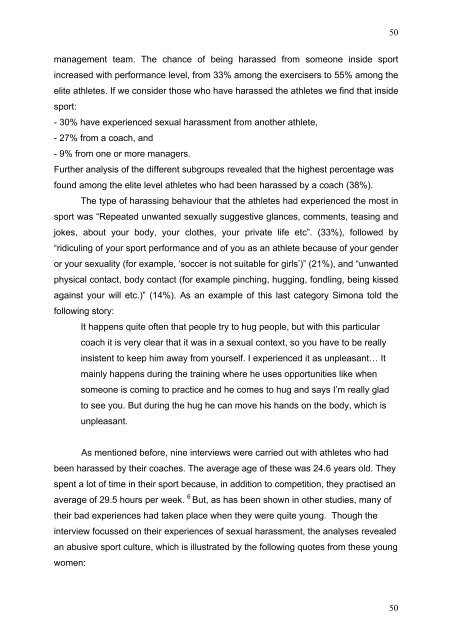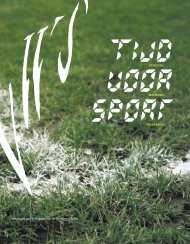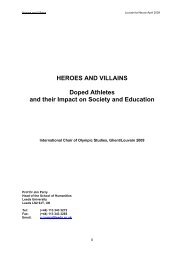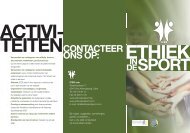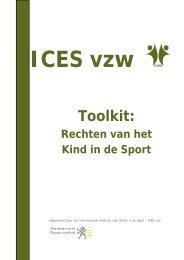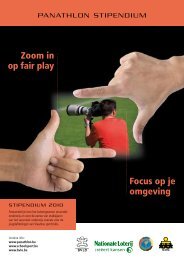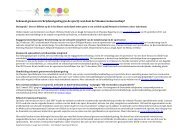Part 3 GLOBAL ISSUES: HARASSMENT AND ABUSE RESEARCH
Part 3 GLOBAL ISSUES: HARASSMENT AND ABUSE RESEARCH
Part 3 GLOBAL ISSUES: HARASSMENT AND ABUSE RESEARCH
Create successful ePaper yourself
Turn your PDF publications into a flip-book with our unique Google optimized e-Paper software.
management team. The chance of being harassed from someone inside sport<br />
increased with performance level, from 33% among the exercisers to 55% among the<br />
elite athletes. If we consider those who have harassed the athletes we find that inside<br />
sport:<br />
- 30% have experienced sexual harassment from another athlete,<br />
- 27% from a coach, and<br />
- 9% from one or more managers.<br />
Further analysis of the different subgroups revealed that the highest percentage was<br />
found among the elite level athletes who had been harassed by a coach (38%).<br />
The type of harassing behaviour that the athletes had experienced the most in<br />
sport was “Repeated unwanted sexually suggestive glances, comments, teasing and<br />
jokes, about your body, your clothes, your private life etc”. (33%), followed by<br />
“ridiculing of your sport performance and of you as an athlete because of your gender<br />
or your sexuality (for example, ‘soccer is not suitable for girls’)” (21%), and “unwanted<br />
physical contact, body contact (for example pinching, hugging, fondling, being kissed<br />
against your will etc.)” (14%). As an example of this last category Simona told the<br />
following story:<br />
It happens quite often that people try to hug people, but with this particular<br />
coach it is very clear that it was in a sexual context, so you have to be really<br />
insistent to keep him away from yourself. I experienced it as unpleasant… It<br />
mainly happens during the training where he uses opportunities like when<br />
someone is coming to practice and he comes to hug and says I’m really glad<br />
to see you. But during the hug he can move his hands on the body, which is<br />
unpleasant.<br />
As mentioned before, nine interviews were carried out with athletes who had<br />
been harassed by their coaches. The average age of these was 24.6 years old. They<br />
spent a lot of time in their sport because, in addition to competition, they practised an<br />
average of 29.5 hours per week. 6 But, as has been shown in other studies, many of<br />
their bad experiences had taken place when they were quite young. Though the<br />
interview focussed on their experiences of sexual harassment, the analyses revealed<br />
an abusive sport culture, which is illustrated by the following quotes from these young<br />
women:<br />
50<br />
50


